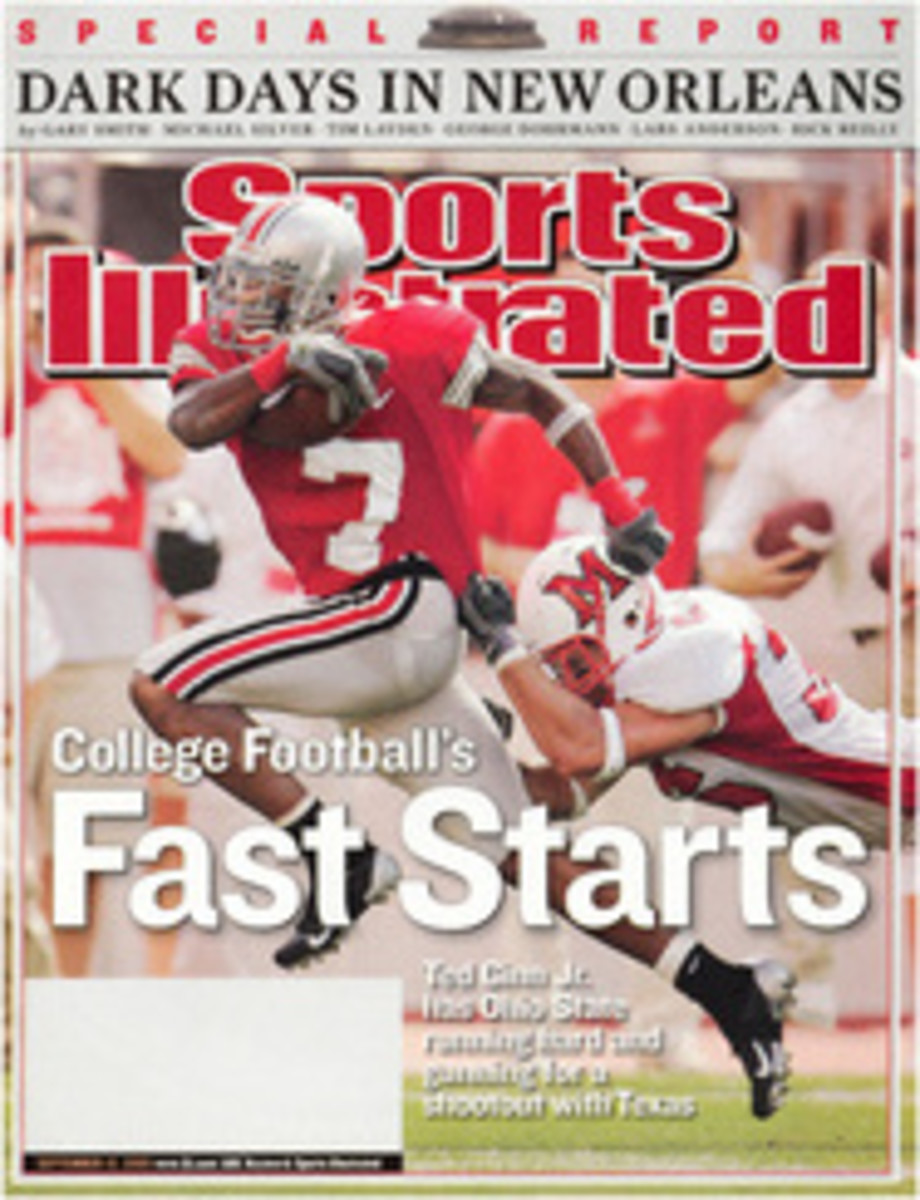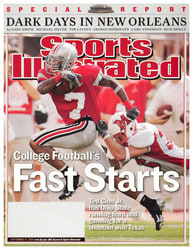
Ready for Anything
The evening's lineup card isn't posted yet on the corkboard at the entrance to the Los Angeles Angels' clubhouse, and here comes Chone Figgins hauling his beaten, blue duffel bag. It's nearly half his 5'7" size, that bag. Figgins bats from both sides of the plate, plays six positions and is finicky about every one of them. That's where the bag comes in. It holds five gloves--one each for third base, shortstop, second base and the outfield, plus one backup--and two bats, a 32-ouncer for hitting righthanded, a 31-ouncer for hitting lefthanded. ¶ "The card never gets there until BP, so I bring the bag with me," Figgins says. "Then I can work out at whatever position the lineup finally says." Before he started lugging his equipment around, if there was a double switch during a game, Figgins would have to run back to the clubhouse for another glove. "I got tired of doing it, so I figured I'd make it easier and carry one big bag." He pauses, wearily. "That bag kind of gets heavy."
The 27-year-old Figgins (his first name is pronounced SHAWN) is the game's most versatile--and itinerant--every-day player. At week's end he had started 132 of his team's 136 games and played every position but catcher, first base and pitcher. The most starts, 37, had come at third. A leadoff hitter batting .288 with 48 stolen bases (tied for second in the majors), he had helped Los Angeles achieve a one-game lead in the American League West by allowing the Angels to paper over injuries that might have ruined the season for most contenders.
In April, Figgins held down second base while Adam Kennedy recovered from knee surgery. In May and June he played outfield for 2 1/2 weeks while Vladimir Guerrero nursed a shoulder strain. And for most of July and August, with Dallas McPherson hobbled by a bone spur in his left hip that eventually ended his season, Figgins filled in at third. Last week, when the Angels took two of three in a stare-down AL West series with the Oakland A's (Figgins went 3 for 3 with two stolen bases in the rubber game, a 3-0 Angels win) and two of three from the Seattle Mariners, he played centerfield for five games before returning to second on Sunday.
"There's no drop-off when he takes somebody's place," says Texas Rangers manager Buck Showalter of Figgins. "I don't even want to call him a utility player; he's an every-day irregular. The irregular about him is that he doesn't play the same place every day. He's a heck of a weapon. Guerrero is a great player, but [Figgins] is as valuable a player as they have. Everybody says, 'Hey, we've got to get a guy like that.' Well, good luck finding a guy like him."
Besides being ever ready for emergencies, Figgins's greatest value is the daily flexibility he offers the Angels, who can give breathers to their regulars and exploit matchup advantages. On Aug. 26 against the Tampa Bay Devil Rays at Tropicana Field in St. Petersburg (a 45-minute drive from Brandon, Fla., where Figgins was raised), manager Mike Scioscia was eager to spark the offense, stack the lineup with righthanders against lefthander Casey Fossum and sit slumping centerfielder Steve Finley. So Scioscia put Figgins in center, the switch-hitting Maicer Izturis at second and righthanded-hitting Robb Quinlan at third, while giving the lefty-swinging Kennedy a night off. Though the Angels lost 12-8, Izturis and Quinlan combined for five hits and four RBIs. Four days later, desperate for consistent production in an increasingly tight division race, Scioscia benched Finley (batting .215) and declared Figgins the every-day centerfielder. How many potential playoff teams can mothball a $6 million-a-year Gold Glove winner, replace him with a natural infielder making $390,000 and say they have improved?
Figgins allows Scioscia, a manager who likes to tinker, the same leeway in the late innings. Sixteen times this season Figgins has played two positions in a game. (The Angels are 10-6 on those occasions.) He permits what Scioscia calls an "American League double switch," keeping a pinch runner's bat in the lineup or facilitating a defensive upgrade. On June 17 against the Florida Marlins the Angels were tied 2-2 in the bottom of the ninth when Scioscia pinch-ran outfielder Jeff DaVanon for sluggish catcher Bengie Molina, who represented the winning run. When the game went to extra innings Scioscia shifted Figgins from leftfield to third base so DaVanon could stay in. In the bottom of the 11th DaVanon was still around to slash the game-winning single in a 3-2 win. "[Figgins] lets you rework your defense to keep the offensive matchups you want," Scioscia says. "You talk about Vlady and [ace righthander] Bartolo Colon, but Figgy's versatility is the most valuable thing we have going."
Figgins played only shortstop at Brandon High. "I would put him at short," says his high school coach, Greg Parris, "and tell the third baseman to play on the line, the leftfielder and centerfielder to play up against the wall and let Chone catch everything in between." In '97 the Colorado Rockies drafted Figgins out of Brandon in the fourth round and asked him to learn second base because Juan Uribe, now with the Chicago White Sox, outranked him on the organizational depth chart at short. The Rockies traded Figgins to the Angels in July 2001 for outfielder Kimera Bartee (who has since retired). Figgins was a late-season callup during the Angels' World Series--winning 2002 season. The next spring his defensive grace captured his new team's imagination. Pitching coach Bud Black saw him shagging fly balls and immediately recommended that Figgins learn the nuances of outfield defense. "The way he went after the ball," Black says, "it just looked right."
But to say that Figgins has adapted solely because of his instincts belies his appetite for work and the inquisitive temperament that has him constantly soliciting advice from teammates and dissecting games for hours. When he is slated to start in the outfield, he spends most of BP watching other hitters and trying to gauge wind patterns, judging how far and in what direction balls tend to carry. He peppers leftfielder Garret Anderson with questions about hitters' tendencies and appropriate positioning. "That he's always looking for information shows his professionalism," Anderson says. "He's not just throwing his glove out there. He's smart, and he applies it."
Figgins retains a mildly obsessive attitude toward the game; with his older brother, Demetrius, who spent two seasons as a third baseman in the independent Northeast and North Atlantic leagues and now shares Chone's condo in Newport Beach, Calif., he spends long, late-night hours worrying about his at bats. Figgins's closest friend in baseball, Marlins centerfielder Juan Pierre, recalls that when the two were roommates in '98 with the Rockies' Class A affiliate in Portland, Ore., "it was a nonstop thing. I would give him little stuff about hitting lefthanded: going the other way, waiting and letting the ball get deep. And we were constantly talking the game. He's still the same. He doesn't let it go."
Desmond DeChone Figgins comes from a churchgoing Baptist family that observed baseball seven days a week. His parents, Charles Figgins and Eva Callins, were born on the same day to families who lived in adjacent houses in rural Leary, Ga. Charles ate and breathed the game and taught his sons its rules and fundamentals, stressing its history above all.
"That was the most important thing," says Demetrius, now an instructor at a local batting cage. "He told us about how Hank Aaron worked for an ice company in the off-season, and that's why his forearms and wrists and hands were so strong--from carrying blocks of ice. And about all the African-American players who came before and didn't have a chance to play in [the majors]. It made us appreciate the opportunities we had."
Charles, who moved the family to Brandon when Chone was one and now drives a truck for a carpet company in Orlando, played competitive slo-pitch softball on a traveling team composed mostly of five of Eva's seven brothers and their extended family and friends. The team barnstormed Florida playing weekend games, which became impromptu gatherings of the Figgins and Callins families. A coed team played from time to time; Eva was a first and third baseman. Chone cut his teeth in the kids' pickup games, tossing and slapping wadded paper cups until he was old enough to swing a bat. "Groomed for it, I guess," he says.
Because money was tight, Charles had his sons help him work odd jobs around Tampa. "During the summers I remember we'd clean a building, buy chicken wings and come home, lay on the floor and watch baseball all night," Charles says. "They were my sons, but they were like my best friends."
Now Figgins is most at ease in the routines and rhythms of baseball. He visited Pierre in Miami last winter, arriving late on a Friday night, and after dinner and a few drinks at Mansion, on South Beach, the pair found themselves up late at Pierre's apartment, talking, bats in hand. "He said, 'You want to go hit?'" Figgins recalls. "He knows me. So we went to the stadium, nobody there but us, and hit for an hour or two." It was good to be home.
• For Tom Verducci's Inside Baseball and Mailbag, plus baseball photo galleries, go to SI.com/baseball.
"Everybody says, 'Hey, we've got to get a guy like that,'" the Rangers' Buck Showalter says of Figgins. "WELL, GOOD LUCK finding a guy like him."
Figgins permits what Scioscia calls an "American League double switch," keeping a pinch runner's bat in the lineup or facilitating a DEFENSIVE UPGRADE.
PHOTO
ROBERT BECK
SPEED DEMON Figgins, who was tied for second in the majors with 48 stolen bases, provides a spark at the top of the lineup.
PHOTO
Photograph by Scott Clarke
[See caption above.]
PHOTO
JIM MCISAAC/GETTY IMAGES
HAVE GLOVES, WILL TRAVEL Figgins offers intelligence and instincts whether he's playing centerfield, second base or third.
PHOTO
ROBERT BECK
[See caption above.]
PHOTO
SCOTT CLARKE
[See caption above.]

